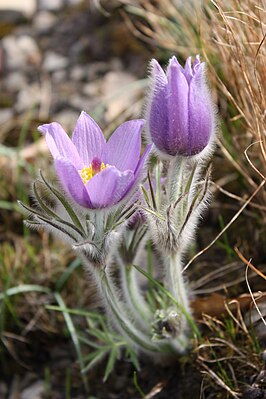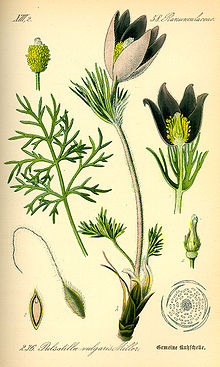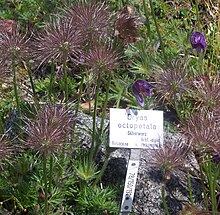Ordinary pasque flower
| Ordinary pasque flower | ||||||||||||
|---|---|---|---|---|---|---|---|---|---|---|---|---|

Common pasque flower |
||||||||||||
| Systematics | ||||||||||||
|
||||||||||||
| Scientific name | ||||||||||||
| Pulsatilla vulgaris | ||||||||||||
| Mill. |
The Pasque Flower ( Pulsatilla vulgaris , synonym if considered as a subspecies: Pulsatilla vulgaris subsp. Vulgaris ), also known as the Pasque Flower , is a species of the buttercup family (Ranunculaceae). It is common in western and central Europe.
Origin of name
The shape of the half-closed flower resembles a bell or a pasque flower. The diminutive "Kühchen" led to the designation "kitchen" clamp. A similar derivation applies to the scientific generic name Pulsatilla , which is derived from the Latin word pulsare for to beat, to ring. It is also known under the name of wolf paw, goat beard, sleep flower and hacker's herb. An occurrence of around 50 flowers on the Triebfels near Hossingen is called Hosenglocka in the local Swabian dialect. In High German the translation would be Hossenglocke = shepherd's bell, comparable to Nachtthosser = night shepherd.
description

Otto Wilhelm Thomé : Flora of Germany, Austria and Switzerland , Gera (1885)
Habit and leaf
The common pasque flower grows as a perennial, herbaceous plant that has stature heights of up to 15 centimeters during the flowering period and up to 40 centimeters at the fruiting period. It is deep-rooted and penetrates over 1 meter into the ground.
The leaves are arranged at the base in a rosette and appear at the same time as the flowers. The leaf blade is bipinnate with (two to) three to five (to six) pairs of pinnate to pinnate main pinnate. The leaf blade is composed of about 100 to 150 linear, mostly 2 to 4 (1 to 6) mm wide sections. This distinguishes it from the Pasque Flower, whose leaves consist of only about 40 to 90 linear-lanceolate, mostly 4 to 7 (2 to 12) mm wide sections and only sprout towards the end of the flowering period.
blossom
The flowers stand individually at the end of the stem. In the upper half of the flower stem there is a whorl of three reduced, shaggy hairy bracts that have grown together at the base . It takes on the usual protective function of the missing calyx for the not yet unfolded flower.
The initially nodding flowers appear in March to May. The hermaphroditic flowers are radial symmetry . The yolk yellow stamens are an attractive contrast to the flower envelope, which is bright purple or purple in color , due to anthocyanins . The simple flower envelope, which is not divided into calyx and crown, widens like a bowl over the course of the flowering period.
ecology
The pasque flower is a typical dry plant .
In terms of flower ecology, they are pre-female bluebells that offer plenty of pollen and nectar and are eagerly visited by bees and bumblebees . Ants also get the nectar, but they do not pollinate and are therefore considered nectar robbers. The bracts are hairy on the outside to prevent excessive water evaporation.
Like many other flowering plants, the pasque flower has a number of mechanisms of propagation in order to colonize its surroundings.
In the fruit state, a nut develops from each individual carpel , on which the stylus forms a strongly elongated and shaggy hairy feather tail. During fruit development, the stem of the flower elongates almost twice the length during the flowering period. The fruits , which are known as feather-tailed fliers , are thus raised above the surrounding vegetation. In dry weather, gusts of wind tear the individual feather-tailed flyers out of the fruit heads and carry them far away (meteorochory).
In wet weather, the fruits adhere to the fur of animals passing by; they are counted among the water adherents , a sub-form of Velcro spreading ( epichory ).
However, the fruits can also move "independently" as ground crawlers. The feather tail, which is bent at right angles when it is dry, slowly stretches through water absorption, while the fruit rotates around itself once or twice at the same time. If dry and wet weather alternates, the fruits can move independently by about 10 to 20 centimeters from the mother plant ( herpochoria ).
The nuts also have the ability to dig deep into the ground with their sharp tips using hygroscopic movements in order to germinate later.
The pasque flower is attacked by the rust fungus Coleosporium pulsatillae . The smut fungus Urocystis pulsatillae was also detected on the common pasque flower.
Chromosome number
The number of chromosomes is 2n = 32.
distribution
The common pasque flower prefers calcareous soils and is widespread in Western and Central Europe, but is now a rare species in the entire area. It occurs from France via Germany north to Denmark and southern Sweden . An isolated partial area is located in the Central England . In the east, isolated deposits reach as far as western Poland and Lower Austria . A former deposit in southern Finland is extinct. To the east, from Lower Austria to the Ukraine , the common pasque flower is represented by the large pasque flower ( Pulsatilla grandis ), which also occurs in a few places in Bavaria and Thuringia .
In Germany today the pasque flower occurs almost only in the low mountain range . Areas with base-rich bedrock (limestone, limestone slate) are preferred. The relatively closed area extends from the Swabian and Franconian Alb to the north to the Eifel and Thuringia . Areas with acidic bedrock form deposit gaps. Most of the former deposits in the north German lowlands are extinct - relict stocks can still be found in Wendland, Lower Saxony, for example . There are also isolated occurrences in the area of the gravel terraces in the Bavarian Alpine Foreland . In Austria, these are continued on the gravel terraces in the central region of Upper Austria , i.e. in the vicinity of Wels , Linz and Steyr .
In Switzerland the pasque flower occurs along the south-eastern edge of the Swiss Jura , in the northernmost part of the Central Plateau and in the area around Chur and is known in dialect as "Güggelrose" (cockerel rose).
In Luxembourg , Pulsatilla vulgaris is called Däiwelsbaart (devil's beard) and occurs in a plant community with some heat-loving orchids on dry grass slopes , e.g. B. in the Moselle valley, in the NSG Deiwelskopp and in the Kiischpelt ( Ösling ).

In Hersbrucker Switzerland the pasque flower is often found in bloom with the cypress milkweed . Forest anemones often follow it in May, while silver thistles regularly colonize their location in autumn
Location
The natural habitat of the common pasque flower are light pine forests and grasslands , mostly on a sunny hillside on calcareous soil . The species has relatively high temperature requirements and is therefore absent from summer-cool landscapes. It is also very light-loving and disappears very quickly when over-fertilized under the pressure of competition from other plants.
Systematics
The species name Pulsatilla vulgaris was published in 1768 by Philip Miller in The Gardeners Dictionary , eighth edition, no. 1 (there no page numbers are used, but letters PU for Pulsatilla).
The name Anemone pulsatilla was published in 1753 by Carl von Linné in Species Plantarum , 1, p. 539. The genus Pulsatilla differs from the plant genus Anemone by the formation of feather-tailed nuts. For this reason, the species were later assigned to their own genus.
On the Swedish island of Gotland in the Baltic Sea, there is an independent population group known as the subspecies Pulsatilla vulgaris subsp. gotlandica Zämelis & Paegle. Another isolated population group is the Innsbruck pasque flower ( Pulsatilla vulgaris subsp. Oenipontana ), which may represent an intermediate form to the pasque flower in terms of its characteristics. It occurs endemically only at the foot of the southern slopes of the Karwendel Mountains in the greater Innsbruck area.
The common pasque flower described here ie S. ( Pulsatilla vulgaris s. Str. ), The closely related pasque flower ( Pulsatilla grandis ) and other species that are more widespread in the east can also be understood as subspecies of a species. Due to the rules of nomenclature, this species can also be called Pulsatilla vulgaris (see Latin), but it is more broadly defined than the clan described here. The subspecies are called Pulsatilla vulgaris subsp. vulgaris , Pulsatilla vulgaris subsp. grandis etc.
In the east of Central Europe and further east, the common pasque flower is represented by the pasque flower ( Pulsatilla grandis or Pulsatilla vulgaris subsp. Grandis ( Wender. ) Zämelis ), which occurs in a few places in Bavaria and Thuringia . The second Pulsatilla species that is found somewhat more regularly in Germany besides the common pasque flower is the meadow pasque flower ( Pulsatilla pratensis ).
Common names
There are many common names for this species, some of which are only regional : Arschcucke ( Austria ), Beißwurz ( Switzerland ), Bisswurz (Switzerland), Biernblomen ( Transylvania ), Bitzblume ( Saxony ), Bitzwurz (Switzerland), Bocksbart, Bockskraut ( Silesia ), Gadelosen ( Rhine ), Glocken ( Chur ), Güggelblume (Switzerland), Gugguche ( Stettin ), Gugguros (Stettin), Gungerose (Stettin), Hackelkraut ( East Prussia ), Hackenkraut, Hacketkraut, Heuschlefen ( Swabia ), Isterbleam (Transylvania), Klockenblume ( Unterweser ), Kronblom ( Altmark ), Küchenblümlein ( Aargau ), Pasque Flower ( too general because the other species of the genus are also called like this), Pasque Flower ( Alsace ), Kuhn's bell, Kuhschellen (too general because the other species of the genus are also called that way) , Mannskraut, ruug Moderkrut ( Holstein ), mother flowers, Easter flowers (Alsace, Eichstädt), Easter pebbles, plump flowers (Transylvania near Jakobsdorf), sheep flowers (Eichstädt), sheep weed, Schlottenblumen (Alsace, East Prussia), Schlotterblume ( Schwyz , U nterwalden ), Siebenschläferl ( Henneberg ), Tageschlaf (Silesia), Tagschläferle (Henneberg), Uisterblommen (Transylvania), Weinkraut (Silesia), Wildmannskraut and Wolfspfote ( Mosel ) are common.
Endangerment and stock situation
The occurrence of the Pasque Flower is linked to the presence of their preferred habitat types. It is therefore particularly affected by the changes in modern agriculture that have taken place over the course of the 20th century. The use of fertilizers has also led to a decline in poor grassland, as has the abandonment of livestock farming in some areas with the subsequent conversion of pastureland into arable land. In addition, areas with favorable climatic conditions in which the pasque flower occurs are often densely populated. This has led to further loss of habitat through the construction of settlements and traffic areas on unprofitable agricultural land.
In Germany the Pasque Flower is threatened with extinction according to the Red Lists in the federal states of Schleswig-Holstein , Lower Saxony , Mecklenburg-Western Pomerania and Brandenburg , and is already extinct in Bremen , Hamburg and Berlin . The population situation in Saxony-Anhalt , where this species is classified as endangered, is not quite as dramatic as in the rest of northern Germany . It is very rare in Saxony . It is classified as endangered in all other federal states except Bavaria and nationwide. According to the Federal Species Protection Ordinance, it is a particularly protected species.
In Austria the species was still a common species around 1900 in the poor grasslands of the Welser Heide , on the terraced gravel between Wels and Linz . In this area it only occurs sporadically. The largest deposits in Austria that are still known today are limited to the area around Steyr . In the Red List it is listed as critically endangered. The same classification also applies to Innsbruck pasque flower ( P. vulgaris subsp. Oenipontana ). This species is strictly protected in all affected federal states.
Use as an ornamental plant
Among the species of the pasque flower genus, the pasque flower is the only one that is more commonly used in gardens. The other species have such specific requirements that they are essentially restricted to botanical gardens .
The herb book authors of the 16th century knew the common pasque flower as a plant that only occurs in the wild. The plant lover and Nuremberg city doctor Joachim Camerarius counted them as one of the flowers kept in his garden in 1588, although he was probably an exception. Its use remained extremely rare, even towards the end of the 19th century it was very rarely found in flower gardens. It was only when the creation of rock gardens became popular that the pasque flower became more widespread as an ornamental garden plant and is now often found in the range of perennial nurseries and garden centers.
In the meantime, several varieties of the common pasque flower have been created through selection and the cross-breeding of other species . These differ from the original species in their flower color, which ranges from white to pink to red.
The common pasque flower as a poisonous plant
All parts of the pasque flower are very poisonous . Among other things , it contains protoanemonin , which is an extremely strong irritant for the skin and mucous membranes. Even handling the plant can lead to the formation of blisters, burns and inflammation of the affected skin areas. The consumption of parts of the plant can lead to kidney infections, stomach and intestinal problems and paralysis of the central nervous system. Protoanemonin only converts into the less toxic anemonin when it dries . The Pasque Flower also contains saponins , resins and tannins .
Poisoning from consumption of the plant is treated by administering activated charcoal and inducing vomiting , depending on the degree of poisoning . Gastric lavage , electrolyte substitution and, if necessary, artificial respiration are also part of the therapeutic measures.
Use in herbal medicine
Cow puffs were already used as a remedy in ancient times . Hippocrates used them against hysterical anxiety and to promote menstruation. It has never found much use in folk medicine , which is certainly also due to its properties as a powerful skin irritant. Only from Russian folk medicine is known a use for headaches and colds , where the freshly crushed leaves were placed on the back of the head. As a homeopathic remedy, Pulsatilla is used for many and above all changing symptoms.
The pasque flower in superstition
Admiration for the beauty of the pasque flower seems to be a modern phenomenon. To our ancestors, the plant, with its silky, shiny head, which appears as a fruit cluster after flowering, was rather eerie. He was called devil's beard or goat beard. In Brandenburg people were even convinced that the fruit stand would mark the place where the hunter had shot a witch down from the air. In other regions it was believed that if you brought the pasque flower into your house, the young goslings would suffocate in their eggs.
Flower of the year
The Pasque Flower was voted Flower of the Year 1996 to draw attention to its threatened status.
literature
- Angelika Lüttig, Juliane Kasten: Rose hip & Co - blossoms, fruits and spread of European plants. Fauna, Nottuln 2003, ISBN 3-935980-90-6
- Andreas Alberts, Peter Mullen: Poisonous plants in nature and the garden. Franckh-Kosmos, Stuttgart 2003, ISBN 3-440-09550-9
- Manfred Bocksch: The practical book of medicinal plants - characteristics, medicinal effects, application, customs. BLV Verlagsgesellschaft, Munich 1996, ISBN 3-405-14937-1
- Detlev Arens : Sixty native wild plants in vivid portraits. DuMont, Cologne 1991, ISBN 3-7701-2516-9
- Heinz-Dieter Krausch : Imperial crown and peonies red ... - Discovery and introduction of our garden flowers. Dölling and Galitz, Hamburg 2003, ISBN 3-935549-23-7
Individual evidence
- ↑ Keppler teaching assistant: Questionnaire on folklore tradition . State Office for Württ. Folklore,> Meßstetten 1900.
- ↑ Winfried Groh (whg): schwarzwaelder-bote.de In: Schwarzwälder Bote from October 14, 2015.
- ^ Johann Christof von Schmid: Swabian dictionary . Ed .: Schweizerbart. Stuttgart 1832, p. 288 .
- ↑ Peter Zwetko: The rust mushrooms Austria. (PDF; 1.8 MB). Supplement and host-parasite directory to the 2nd edition of the Catalogus Florae Austriae, III. Part, Book 1, Uredinales.
- ↑ Cybertruffle's Robigalia, Observations of fungi and their associated organisms, accessed on March 3, 2015.
- ^ Erich Oberdorfer : Plant-sociological excursion flora for Germany and neighboring areas. 8th edition. Verlag Eugen Ulmer, Stuttgart 2001, ISBN 3-8001-3131-5 , p. 404.
- ↑ Miller's publication of Pulsatilla vulgaris scanned at biodiversitylibrary.org .
- ^ Linné first publication of Anemone pulsatilla scanned at biodiversitylibrary.org .
- ^ Georg August Pritzel , Carl Jessen : The German folk names of plants. New contribution to the German linguistic treasure. Philipp Cohen, Hannover 1882, page 29 f., Online.
Web links
- Ordinary pasque flower. In: FloraWeb.de.
- Ordinary pasque flower . In: BiolFlor, the database of biological-ecological characteristics of the flora of Germany.
- Profile and distribution map for Bavaria . In: Botanical Information Hub of Bavaria .
- Pulsatilla vulgaris Mill. In: Info Flora , the national data and information center for Swiss flora . Retrieved October 19, 2015.
- Distribution in the northern hemisphere according to: Eric Hultén , Magnus Fries: Atlas of North European vascular plants. 1986, ISBN 3-87429-263-0 .
- Thomas Meyer: Data sheet with identification key and photos at Flora-de: Flora von Deutschland (old name of the website: Flowers in Swabia )
- The pasqueflower as a poisonous plant. on giftpflanze.com.









